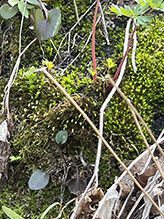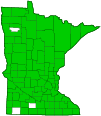Mosses
(Division Bryophyta)
Overview • Description • Distribution • Taxonomy
Description |
||
A moss is distinguished by a gametophyte generation that consists of a green shoot with a dense arrangement of thin, flat, green leaves, and is anchored to the substrate by branched, multicellular filaments (rhizoids); and by a sporophyte capsule that has a column of sterile cells in the center. |
||
Distribution |
||||
|
Sources
|
|||
| 7/19/2022 | ||||
Taxonomy |
|||||||||||||||||||||||||||||||||||||
| Kingdom | Plantae (Plants) | ||||||||||||||||||||||||||||||||||||
Subordinate Taxa |
|||||||||||||||||||||||||||||||||||||
|
|||||||||||||||||||||||||||||||||||||
Synonyms |
|||||||||||||||||||||||||||||||||||||
|
|||||||||||||||||||||||||||||||||||||
Common Names |
|||||||||||||||||||||||||||||||||||||
mosses |
|||||||||||||||||||||||||||||||||||||
Glossary
Rhizoid
A filament arising from the lower stem of a moss, liverwort, or alga that anchors it to a substrate.
Visitor Photos |
|||||
Share your photo of this plant. |
|||||
| This button not working for you? Simply email us at info@MinnesotaSeasons.com. Attach one or more photos and, if you like, a caption. |
|||||
Nancy Falkum |
|||||
 |
|||||
MinnesotaSeasons.com Photos |
|||||
|
|||||

Visitor Videos |
|||
Share your video of this plant. |
|||
| This button not working for you? Simply email us at info@MinnesotaSeasons.com. Attach a video, a YouTube link, or a cloud storage link. |
|||
Other Videos |
|||
| Moss (Bryophyta) Wholesome Day |
|||
About
Sep 24, 2015 Mosses are small flowerless plants that usually grow in dense green clumps or mats, in damp or shady locations. The individual plants are usually composed of simple, one-cell thick leaves, covering a thin stem that supports them but does not conduct water and nutrients. At certain times they produce thin stalks topped with capsules containing spores. There are around 12 000 species of moss that can be found throughout the world. Mosses are usually bright green in color. Some species can be pale green almost white, bluish-green, yellowish-green or velvety black green. The main commercial use of mosses is for decorative purposes, such as in gardens and in the florist trade. Traditional uses of mosses included as insulation and for the ability to absorb liquids up to 20 times their weight. They are small herbaceous plants that absorb water and nutrients mainly through their leaves and harvest carbon dioxide and sunlight to create food by photosynthesis. They do not have proper roots, but have threadlike rhizoids that anchor them to their substrate. The fossil record of moss is sparse, due to their soft-walled and fragile nature. When the ancestors of today's moss started to spread on land 470 million years ago, they absorbed CO2 from the atmosphere and extracted minerals by secreting organic acids that dissolved the rocks they were growing on. Since mosses have no vascular system to transport water through the plant or waterproofing systems to prevent tissue water from evaporating, they must have a damp environment in which to grow, and a surrounding of liquid water to reproduce. Shade tolerance varies by species, just as it does with higher plants. In most areas, mosses grow chiefly in areas of dampness and shade, such as wooded areas and at the edges of streams; but they can grow anywhere in cool damp cloudy climates, and some species are adapted to sunny, seasonally dry areas like alpine rocks or stabilized sand dunes. It is generally believed that in northern latitudes, the north side of trees and rocks will generally have more moss growth on average than other sides. This is assumed to be because the sun on the south side creates a dry environment. South of the equator the reverse would be true. However, naturalists feel that mosses grow on the damper side of trees and rocks. In some cases, such as sunny climates in temperate northern latitudes, this will be the shaded north side of the tree or rock. Moss can stop its metabolism almost completely during the hot periods of the year when water is not available. They are also indicators of pollution as they can grow only in clean environments. Preindustrial societies made use of the mosses growing in their areas. Laplanders and other circumpolar people used mosses for bedding. North American tribal people used mosses for basketry, bedding and wound dressing. Some sphagnum mosses can absorb up to 20 times their own weight in water. In World War I, Sphagnum mosses were used as first-aid dressings on soldiers' wounds, as these mosses said to absorb liquids three times faster than cotton, retain liquids better, better distribute liquids uniformly throughout themselves, and are cooler, softer, and be less irritating. It was also claimed that they have mild antibacterial properties. Certain animals, such as reindeer, consume mosses because they contain chemical which warms the blood of animal. The Lifespan of moss depends on the species. It ranges from 2 to 10 years. |
|||
| Plant kingdom part 3 - Bryophyta (Mosses and Liverworts) Bio Master |
|||
About
Aug 12, 2018 Video presentation/ Classes for Class 12/Plus 2/CBSE students |
|||
| Mosses Bryophyte life cycle Nook Nattapon |
|||
About
Sep 13, 2013 Bio I - K.Pl. |
|||

Created: 7/19/2022
Last Updated:






